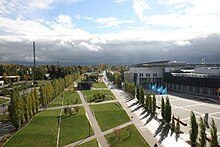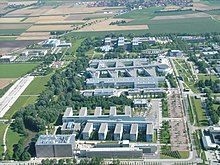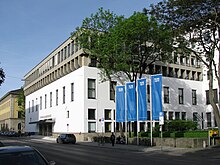Technical University of Munich
Technische Universität München | |
 | |
| Motto | The Entrepreneurial University |
|---|---|
| Type | Public |
| Established | 1868 |
| Founder | Ludwig II of Bavaria |
Academic affiliation | |
| Budget | €1,839.2 million(2022)[1]
|
| President | Thomas Hofmann (list of presidents) |
Academic staff | 666 professors 7,883(other academic staff)[1] |
Administrative staff | 3,502(without university hospital)[1] |
| Students | 52,580(WS 2023–24)[1] |
| Address | Arcisstraße 21 ,,,80333 ,48°08′56″N11°34′01″E/ 48.149°N 11.567°E48°08′53″N11°34′05″E/ 48.14806°N 11.56806°E |
| Campus | Urban |
| Colors | Blue,White |
| Website | tum.de |
 | |
TheTechnical University of Munich(TUMorTU Munich;German:Technische Universität München) is apublicresearch universityinMunich,Bavaria,Germany.It specializes inengineering,technology,medicine,andappliedandnatural sciences.
Established in 1868 by KingLudwig II of Bavaria,the university now has additional campuses inGarching,Freising,Heilbronn,Straubing,andSingapore,with theGarching campusbeing its largest. The university is organized into seven schools, and is supported by numerous research centers. It is one of the largest universities in Germany, with 52,580 students and an annual budget of €1,839.2 million including theuniversity hospital.[1]
AUniversity of Excellenceunder theGerman Universities Excellence Initiative,[2]TUM is among the leading universities in theEuropean Union.[3]Its researchers and alumni include 18Nobellaureates and 24Leibniz Prizewinners.[1]
History[edit]
19th century[edit]

In 1868, KingLudwig II of Bavariafounded thePolytechnische Schule MünchenwithKarl Maximilian von Bauernfeindas founding director. The new school had its premises at Arcisstraße, where it is still located today. At that time, around 350 students were supervised by 24 professors and 21 lecturers. The institution was divided into six departments: The "General Department" (mathematics,natural sciences,humanities,lawandeconomics), the "Engineering Department" (civil engineeringandsurveying), the "Building Construction Department" (architecture), the "Mechanical-Technical Department" (mechanical engineering), the "Chemical-Technical Department" (chemistry), and the "Agricultural Department".
In 1877, thePolytechnische Schule Münchenbecame theTechnische Hochschule München(TH München), and in 1901 it was granted the right to awarddoctorates.With an average of 2,600 to 2,800 students, the TH München became for a time Germany's largesttechnical university,ahead of theTH Berlin.In 1970 the institution was renamedTechnische Universität München.
20th century[edit]


In 1906,Anna Boyksenbecame the first female student to enroll inelectrical engineering,after the Bavarian government had allowed women to study at technical universities in theGerman Empire. Martha Schneider-Bürgerbecame the first German femalecivil engineerto graduate from the university in 1927.[4]
In 1913,Jonathan Zenneckbecame director of the newly createdPhysics Institute.
During theWeimar Republic,the TH München faced the challenge of limited resources and was drawn into radical political conflicts during theNovember Revolution,theGreat Depression,and therise of Adolf Hitler.Two of the 16 Nazis killed inHitler's failed coup attemptin 1923 were students at the university. TheNational Socialist German Students' Leaguebecame the strongest faction in theGeneral Students' Committeein 1930, and Jewish and politically unpopular professors were terrorized by the young students.[5]
After Hitler took power, the TH was soonalignedand a "Führer rector" was appointed, with the deans directly responsible to him. TheFührerprinzipwas also imposed on universities, resulting in a significant restriction of the autonomy of the TH München. In 1933, the newly enactedLaw for the Restoration of the Professional Civil Serviceled to the dismissal of staff deemed "non-Aryan"or married to" non-Aryans, "as well as politically" undesirable "professors.Jewishstudents lost their rights and were banned from enrolling after 1938.
The university was deeply involved in the crimes of the Nazi regime. For instance, Heinz Henseler, a professor in charge of animal breeding at the university, headed a new "Colonial Science Seminar" from 1940. The seminar focused on exploring how to "Germanize" the landscapes of Poland and Russia forfuture colonizationand settlement during the war. The entire Faculty of Agriculture was influenced by the ideology ofblood and soil,and agricultural scientists had no qualms about using forced laborers and prisoners of war on university experimental farms. Henseler repeatedly asked his former student and SS chiefHeinrich Himmlerfor additional land and led several excursions to the SS herb garden on the grounds of theDachau concentration campwith his students.[5]
DuringWorld War II,the TH München conducted extensive research in armaments to support the war effort. Notable professors during this time included aircraft designerWilly Messerschmittand physicistWalther Meissner.Despite the war, high-level basic research continued to be conducted in some institutes, as some professors, staff members, and students dared to disobey and resist.Nobel laureateHans Fischerprotected Jewish students from Nazi persecution. He committed suicide shortly before the end of the war.[6]
Post World War II[edit]

During the war, 80 percent of the university's facilities in Munich had beendestroyed.Under these difficult conditions, teaching resumed in April 1946.
In 1956, the construction of aresearch reactorinGarchingwas the beginning of the Garching campus. In 1969, thephysics departmentbuilding was opened there, followed in 1977 by new buildings for thechemistry,biologyandgeosciencedepartments.
Between 1868 and 1870 the architectArnold Zenettioversaw the construction of several hospital buildings which are today attached to the Munich universities or form part of the TUM campus.[7]In 1967, aTUM School of Medicinewas founded with campuses in the buildings ofRechts der Isar Hospital.By 1968, the so called TH München comprised six faculties, 8,400 students, and 5,700 staff. In 1972, theZentrale Hochschulsportanlage,a 45-hectare sports center, was built on the grounds of the1972 Summer Olympics.
In 1970, the TH München was renamed to its present nameTechnische Universität München.When the Bavarian Higher Education Act came into force in 1974, the six faculties were replaced by eleven departments. In 1992, the field ofcomputer sciencewas established as an independentDepartment of Informatics,having previously been part of theDepartment of Mathematicssince 1967.
21st century[edit]

In 2002,TUM Asiawas founded in Singapore, in cooperation with theNanyang Technological Universityand theNational University of Singapore.It was the first time that a German university had established a subsidiary abroad.
TheDepartment of Sport and Health Sciencesand theSchool of Managementwere established in 2002. TheWeihenstephandepartments were combined into the "Weihenstephan Centre of Life and Food Sciences" (WZW), which would later become theSchool of Life Sciences.With the establishment of theSchool of Educationin 2009, theSchool of Governancein 2016 and theDepartment of Aerospace and Geodesyin 2018, the university comprises 15 schools and departments.
Since the inception of theGerman Universities Excellence Initiativein 2006, TUM has won every round of evaluation and the titleUniversity of Excellence.[2]
As part of itsAgenda 2030,the 15 schools and departments were consolidated into seven schools by 2023.[8]
Campuses[edit]
TUM's academic faculties are divided amongst numerous campuses.
Munich[edit]

The historic Main Campus (Stammgelände) is located inMaxvorstadt,the central borough of Munich. Today, the departments ofArchitecture,Civil, Geo and Environmental Engineering,Electrical and Computer Engineeringand the Schools ofManagement,Governance,Educationare located here.
TheTUM School of Medicineis located at the site of itsuniversity hospital,theRechts der Isar Hospital,in the district ofHaidhausen.
TheTUM Department of Sport and Health Sciencesis located in theOlympiapark,the former site of the1972 Summer Olympics.
Garching[edit]


The campus inGarching,located around 10 km north of Munich, has grown to become the largest TUM campus. In the last decades, the departments ofPhysics,Chemistry,Mechanical Engineering,InformaticsandMathematicshave all relocated from their former buildings in the Main Campus. They have since been joined by numerous research institutes, including theMax Planck InstitutesforPlasma Physics,Astrophysics,Extraterrestrial PhysicsandQuantum Optics,theForschungsreaktor München II(FRM II), the headquarters of theEuropean Southern Observatory(ESO), and theLeibniz Supercomputing Centre,one of the fastestsupercomputersin Europe.[9]
A landmark of the Garching campus is theOskar von Miller Tower,ameteorologicalmeasurement tower with a height of 62 m. The Garching campus is connected toMunichby theAutobahnand theMunich U-Bahn.It has its ownfire department.
Weihenstephan[edit]
The third TUM campus is located 35 km north of Munich inWeihenstephan,Freising.It hosts theSchool of Life Sciences.
Other locations[edit]
Additional TUM facilities are located inOttobrunn(Department of Aerospace and Geodesy),[10]Straubing,[11]Heilbronn,[12]andSingapore.
TUM Asia[edit]
TUM operates a subsidiary inSingapore.In 2001, theGerman Institute of Science and Technology (GIST) – TUM Asiawas founded in partnership with theNational University of Singaporeand theNanyang Technological University,offering a range ofMaster'sprograms. In 2010, TUM Asia started offering bachelor's degrees in collaboration with theSingapore Institute of Technology.
In 2010, TUM and theNanyang Technological UniversityfoundedTUMCREATE,a research platform for the improvement ofSingapore's public transportation.[13]
Academics[edit]


Schools and departments[edit]
As atechnical university,the university specializes inengineering,technology,medicine,and theappliedandnatural sciences.Compared to aVolluniversität(a universal university), it lacks theGeisteswissenschaften,includinglawand many branches of thesocial sciences.
As of 2023, the Technical University of Munich is organized into seven schools and departments:[14]
| Schools | Students | Female | International |
|---|---|---|---|
|
15,092 | 22.2% | 55.1% |
|
13,285 | 29.6% | 45.1% |
|
4,950 | 35.7% | 39.3% |
|
4,884 | 57.6% | 33.6% |
|
4,393 | 54.6% | 17.0% |
|
6,977 | 39.7% | 53.2% |
|
2,201 | 57.7% | 25.0% |
| TUM Campus Straubing | 798 | 45.0% | 65.3% |
Other institutions include theRechts der Isar Hospital,the TUM Graduate School and theMunich School of Politics and Public Policy.
TheTUM School of Managementistriple accreditedby theEuropean Quality Improvement System(EQUIS), theAssociation to Advance Collegiate Schools of Business(AACSB) and theAssociation of MBAs(AMBA).[15][16][17]
Research[edit]

The Technical University of Munich is one of the most research-focused universities in Europe. This claim is supported by relevant rankings, such as the funding ranking of theGerman Research Foundationand the research ranking of theCentre for Higher Education.[18]
Under theGerman Universities Excellence Initiative,TUM has obtained funding for multiple research clusters, includinge-conversion(energy technology),MCQST(quantum mechanics),ORIGINS(astrophysics,biophysicsandparticle physics), andSYNERGY(neurology).[19]
In addition to the schools and departments, TUM has set up numerousresearch centerswith external cooperation partners.[20]
Integrative research centers (IRCs) combine research with teaching.[20]They include theTUM Institute for Advanced Study(TUM-IAS), theMunich Center for Technology in Society(MCTS), the Munich Data Science Institute (MDSI), the Munich School of Engineering (MSE), the Munich School of BioEngineering (MSB), and the Munich School of Robotics and Machine Intelligence (MSRM).
Corporate research centers (CRCs) carry out research independently of the schools and departments, cooperating with industry partners for application-driven research.[20]They include the research reactorFRM II,the Center for Functional Protein Assemblies (CPA), the Catalysis Research Center (CRC), the center for translational Cancer Research (TranslaTUM), theWalter Schottky Institute(WSI), the Hans Eisenmann-Zentrum for Agricultural Science, and the Institute for Food & Health (ZIEL).
Partnerships[edit]
TUM has over 160 international partnerships, ranging from joint research activities to international study programs. Partners include:[21]
- Europe:ETH Zurich,EPFL,ENSEA,École Centrale Paris,TU Eindhoven,Technical University of Denmark,Technical University of Vienna,NMBU
- United States:MIT,Stanford University,Northwestern University,University of Illinois,Cornell University,University of Texas at Austin,Georgia Tech
- Asia:National University of Singapore,Multimedia University,Hong Kong University of Science and Technology,Huazhong University of Science and Technology,Tsinghua University,University of Tokyo,Indian Institute of Technology Delhi,Amrita University,Sirindhorn International Institute of Technology,
- Australia:Australian National University,University of Melbourne,RMIT University.
Through theErasmus+program and its internationalstudent exchange programTUMexchange, students can complete exchange semesters at partner universities.[22]
Rankings and reputation[edit]
| University rankings | |||||||||||||||||||||||||
|---|---|---|---|---|---|---|---|---|---|---|---|---|---|---|---|---|---|---|---|---|---|---|---|---|---|
| Overall – Global & National | |||||||||||||||||||||||||
| |||||||||||||||||||||||||
| By subject – Global & National | |||||||||||||||||||||||||
| |||||||||||||||||||||||||
Overall rankings[edit]
TUM is ranked 28th worldwide (first in Germany) in theQS World University Rankings2025,[23]30th worldwide (first in Germany) in theTimes Higher Education World University Rankings2024,[24]and 59th worldwide (second in Germany) in theAcademic Ranking of World Universities2023.[25]TUM ranked 11th in Europe in the 2024 QS Europe rankings.[26]In the 2023Nature Indexof academic institutions, TUM ranked 59th worldwide and first in Germany.[30]
In the 2022 edition of the Times Higher Education's Global University Employability Ranking, graduates from TUM were ranked 12th globally and first in Germany.[27]The same year, TUM held the 33rd position globally (also first in Germany) in the Times Higher Education World Reputation Rankings.[31]In the QS World University Sustainability Ranking 2023, TUM was ranked 109th overall and first in Germany.[32]In the Times Higher Education's Impact Rankings 2022 (industry, innovation, and infrastructure), TUM tied for first place worldwide.[33]InReuters' 2019European Most Innovative Universityranking, TUM ranked 7th.[34]
Subject rankings[edit]
In the QS World Rankings, TUM is placed 49th overall[23]and is the highest ranked German university in engineering and technology (19th), natural sciences (23rd), and computer science (31st).[28]In the Times Higher Education World University Rankings, TUM ranks 27th in business and economics, 22nd in the physical sciences, 22nd in engineering and technology, and 15th in computer science, and is the highest ranked German university in these areas.[29]TUM is also ranked first in Germany in several subject areas by ARWU, including computer science and engineering, electrical engineering, aerospace engineering, food science, biotechnology, environmental engineering, medical technology, management, and transportation science.[35]
|
| ||||||||||||||||||||||||||||||||||||||||||||||||||||||||||||||||||||||||||||||||||||||||||||||||||||||||||||||||||||||||||||||||||||||||||||||||||||||||||||||||||||||||||||||||||||||||||||||||||||||||||||||||||||||||||||||||||||||||||||||||||||||||||||||||||||||||||||||
Student life[edit]
As of winter semester 2023/24, 52,580 students are enrolled at TUM, of whom 36% arefemaleand 45% areinternational students.[1]
Student initiatives[edit]
Various initiatives are run by students, includingTEDxTUM, theTUM Speaker Series(past speakers having includedBan Ki-moon,Tony Blair,Bill Gates,Sam AltmanandEric Schmidt),[36]andIKOM,a career fair.[37]
A notable student group is theWorkgroup for Rocketry and Space Flight(WARR), which won allSpaceXHyperloop pod competitionsin 2017 through 2019.[38][39][40] In 2021,TUM Boring,won thetunnel-boring competitionsponsored byThe Boring CompanyinLas Vegas, Nevada.[41]In 2023, a team from the university won second place at theIndy Autonomous Challenge,a autonomous racecar competition in Las Vegas.[42]
Student government[edit]
The Student Council is the main body for university-wide student representation. It elects the General Student Committee (AStA), which represents the professional, economic and social interests of the students, by the Bavarian Higher Education Act. Each school or department will also have a separate Departmental Student Council.[citation needed]
Every year, university elections are held to elect student representatives in the Senate, the university's highest academic authority, and in the faculty councils.[43]
Events[edit]
The Student Council organizes a number of annual festivals and events.TUNIXandGARNIXare week-long open air festivals held every summer.TUNIXis held at theKönigsplatznear the Munich campus, whileGARNIXis held at the Garching campus.GLÜHNIXis achristmas marketheld in front of the Department of Mechanical Engineering every December.MaiTUMis a BavarianMaifest,held at the Main Campus in May each year.[37][44]
Campus life[edit]
TheZentrale Hochschulsportanlage(ZHS) is the largest university sports facility in Germany, offering hundreds of different sports programs.[37]
Music ensembles at TUM include the TUM Chamber Orchestra, the TUMJazz Band,the TUMChoir,and theSymphonisches Ensemble München,a full-sizesymphony orchestra.[37]
Notable people[edit]


Nobel Prize laureates[edit]
17Nobel Prizewinners have studied, taught or researched at the TUM:
- 1927 –Heinrich Otto Wieland,Chemistry (bile acids)
- 1929 –Thomas Mann,Literature (Buddenbrooks)
- 1930 –Hans Fischer,Chemistry (constitution and synthesis ofhaeminandchlorophyll)
- 1961 –Rudolf L. Mößbauer,Physics (Mößbauer effect)
- 1964 –Konrad Emil Bloch,Physiology or Medicine (mechanism andregulationof thecholesterolandfatty acid metabolism)
- 1973 –Ernst Otto Fischer,Chemistry (sandwich complexes)
- 1985 –Klaus von Klitzing,Physics (quantum Hall effect)
- 1986 –Ernst Ruska,Physics (electron microscope)
- 1988 –Johann DeisenhoferandRobert Huber,Chemistry (crystal structure of anintegral membrane protein)
- 1989 –Wolfgang Paul,Physics (ion trap)
- 1991 –Erwin Neher,Physiology or Medicine (function of singleion channelsin cells)
- 2001 –Wolfgang Ketterle,Physics (Bose-Einstein condensationin dilute gases ofalkaliatoms)
- 2007 –Gerhard Ertl,Chemistry (chemical processes on solidsurfaces)
- 2016 –Bernard L. Feringa(TUM-IASfellow), Chemistry (molecular machine)
- 2017 –Joachim Frank,Chemistry (cryo-electron microscopy)
- 2022 –Anton Zeilinger,Physics (Quantum information science)
Scientists[edit]
- Friedrich L. Bauer,computer scientist, known for thestackdata structure
- Rudolf Bayer,computer scientist, known for theB-treeandRed–black tree
- Rudolf Diesel,engineer, inventor of theDiesel engine
- Claude Dornier,airplane designer
- Emil Erlenmeyer,chemist, known for theErlenmeyer flask
- Asta Hampe,engineer, statistician and economist
- Carl von Linde,engineer, discoverer of therefrigeration cycle
- Heinz Maier-Leibnitz,physicist
- Walther Meissner,physicist, known for theMeissner effect
- Willy Messerschmitt,aircraft designer, known for theMesserschmittfighters
- Oskar von Miller,engineer, founder of theDeutsches Museum
- Erich Rieger,astrophysicist, discoverer of theRieger periodicitiesthat permeate theSolar System
See also[edit]
Notes and references[edit]
- ^abcdefg"TUM in figures".Technische Universität München.Retrieved25 January2024.
- ^ab"Final decisions in the German Excellence Strategy".Wissenschaftsrat.de.
- ^"TUM ist beste Universität in Deutschland und EU".www.tum.de.Retrieved1 July2020.
- ^Stiglat, Klaus (2004).Bauingenieure und ihr Werk.Berlin: Ernst & Sohn.ISBN3-433-01665-8.OCLC53848171.
- ^abWetzel, Jakob (20 May 2018)."TU München: Forschung im Dienst der Nazis".Süddeutsche.de(in German).Retrieved9 February2023.
- ^Pabst, p. 321–350
- ^Andres Lepik; Katrin Bäumler, eds. (2018).The Architecture Under King Ludwig II: Palaces and Factories.Walter de Gruyter GmbH. pp. 30–31.ISBN9783035616538.
- ^"TUM Agenda 2030: Innovation durch Talente, Exzellenz und Verantwortung"(PDF).Technische Universität München.
- ^"Das Garchinger Hochschul- und Forschungszentrum".garching.de(in German).Retrieved22 December2020.
- ^"New Department of Aerospace, Aeronautics and Geodesy".Technical University of Munich.21 September 2018.Retrieved22 December2020.
- ^""Straubing in der ersten Liga"".Bayerischer Rundfunk(in German). 20 July 2017.Retrieved22 December2020.
- ^"Mega-endowment for TUM Campus Heilbronn".Technical University of Munich.7 February 2018.Retrieved22 December2020.
- ^"About TUMCREATE".TUM CREATE.Retrieved22 December2020.
- ^"Organizational Structure".Technical University of Munich.Retrieved19 October2022.
- ^"EQUIS Accredited Schools".European Quality Improvement System.20 September 2018.Retrieved24 December2020.
- ^"AACSB-Accredited Business Schools".Association to Advance Collegiate Schools of Business.Retrieved24 December2020.
- ^"Accredited Schools".Association of MBAs.Retrieved24 December2020.
- ^Förderatlas 2018(PDF).Deutsche Forschungsgemeinschaft.2018.
- ^"Clusters of Excellence – Exzellenzstrategie".Technical University of Munich.Retrieved22 December2020.
- ^abc"Research Centers".Technical University of Munich.Retrieved22 December2020.
- ^"International Partner Universities".Technical University of Munich.Retrieved22 December2020.
- ^"Study abroad".TUM Global & Alumni Office.Retrieved22 December2020.
- ^abc"QS World University Rankings 2025".QS World University Rankings.Retrieved6 June2024.
- ^ab"World University Rankings 2024".Times Higher Education World University Rankings.27 September 2023.Retrieved27 September2023.
- ^ab"2023 Academic Ranking of World Universities".Academic Ranking of World Universities.Retrieved15 August2023.
- ^ab"QS World University Rankings: Europe 2024".QS World University Rankings.Retrieved20 September2023.
- ^ab"Best universities for graduate jobs: Global University Employability Ranking 2022".Times Higher Education World University Rankings.23 November 2022.Retrieved23 March2023.
- ^abcdef"QS World University Rankings by Subject 2024".QS World University Rankings.Retrieved10 April2024.
- ^abcdef"World University Rankings by subject".Times Higher Education World University Rankings.Retrieved27 October2023.
- ^"2023 tables: Institutions – academic | Annual tables | Nature Index".Nature.Retrieved5 July2023.
- ^"World Reputation Rankings".Times Higher Education (THE).6 October 2022.Retrieved5 July2023.
- ^"QS Sustainability University Rankings 2023".QS World University Rankings.Retrieved25 August2023.
- ^"Impact Rankings 2022: industry, innovation, and infrastructure".3 April 2022.
- ^"Reuters Top 100: Europe's Most Innovative Universities 2019 announced".Reuters.30 April 2019.Retrieved28 December2020.
- ^ab"ShanghaiRanking's Global Ranking of Academic Subjects 2023".Academic Ranking of World Universities.
- ^"TUM Speakers Series".Retrieved23 December2020.
- ^abcd"Campus life".Technical University of Munich.Retrieved22 December2020.
- ^Boyle, Alan (27 August 2017)."Germany's WARR team wins SpaceX's Hyperloop II race with 201-mph pod run".GeekWire.US.Archivedfrom the original on 25 September 2017.Retrieved26 September2017.
- ^"WARR Hyperloop pod hits 284 mph to win SpaceX competition".The Verge.18 July 2018.Archivedfrom the original on 29 July 2018.Retrieved30 July2018.
- ^"Team TUM wins SpaceX Hyperloop Pod Competition with record 288 mph top speed".TechCrunch.Retrieved28 July2019.
- ^Paleja, Ameya (23 September 2021)."Musk's Boring Company Announces Not-a-Boring Competition Winner".Interesting Engineering.Retrieved26 September2021.
- ^Zeitung, Süddeutsche (8 January 2023)."Messe: TU München belegt erneut zweiten Platz bei Roboterauto-Rennen".Süddeutsche.de(in German).Retrieved9 February2023.
- ^"University elections on July 28, 2020".Technical University of Munich.Retrieved22 December2020.
- ^"Unsere Veranstaltungen – Studentische Vertretung".Technical University of Munich Student Council(in German).Retrieved22 December2020.
Bibliography[edit]
- Pabst, Martin (2006).Technische Universität München: die Geschichte eines Wissenschaftsunternehmens(in German). Berlin: Metropol.ISBN978-3-938690-34-5.OCLC645055557.
- Wengenroth, Ulrich (1993).Technische Universität München - Annäherungen an ihre Geschichte(in German). Technische Universität München.ISBN978-3-929391-03-9.OCLC243765003.
External links[edit]
- Official website
 (in German and English)
(in German and English)
